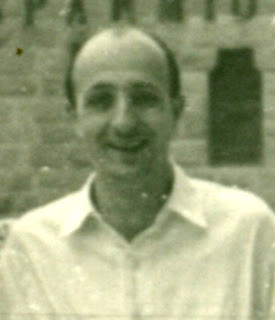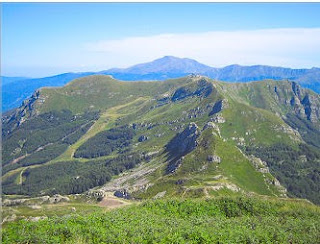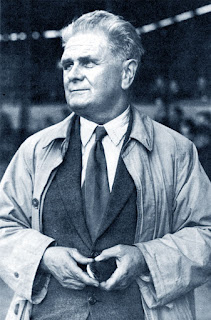Brave freedom fighter whose death is unsolved mystery
 |
| Manrico Ducceschi operated under the codename Pippo as he fought as an Italian partisan |
Ducceschi’s battalion, known as the XI Zona Patrioti, are credited with killing 140 enemy soldiers and capturing more than 8,000. They operated essentially in the western Tuscan Apennines, between the Garfagnana area north of Lucca, the Valdinievole southwest of Pistoia, and the Pistoiese mountains.
He operated under the name of Pippo in honour of his hero, the patriot and revolutionary Giuseppe Mazzini.
Ducceschi's success in partisan operations led to him being placed at the top of the Germans' ‘most wanted’ list. Even his relatives were forced to go into hiding.
After the war, he was honoured by the Allies for the help he provided in the Italian campaign but oddly his deeds were never recognised by the post-war Italian government, nor even by his own comrades in the National Association of Italian Partisans (Anpi).
Moreover, he died in mysterious circumstances in 1948 when he was found hanged in his house in Lucca. His family refused to accept the official verdict of suicide delivered by magistrates investigating his death, believing he was murdered, although a new inquiry opened in the 1970s could not find any evidence to contradict the original verdict.
 |
| Manrico Ducceschi's battalion is credited with killing more than 140 enemy soldiers |
He was serving with the Alpini Corps of the Italian Army in Tarquinia in Lazio when Italy formally surrendered to the Allies on September 8, 1943, but managed to evade capture by the Germans and made his way back to Pistoia - a distance of 250km (155 miles) - mainly on foot.
There he became involved with resistance groups. His organisational skills and training with the Alpini saw him quickly assume leadership roles and by March 1944 he was head of the XI Zona Patrioti. Many of his fellow freedom fighters were political activists but Ducceschi insisted that his group was not aligned with any particular party.
In addition to regular engagements with the enemy, the group scored a major success when they intercepted, at the Abetone Pass in the mountains above Pistoia, a Rear Admiral of the Japanese navy. They seized documents that proved highly useful for the subsequent war operations of the Allies in the Pacific.
This led to closer ties with the Allies, who supplied them with uniforms and equipment, and entrusted them with a 40km (25 miles) stretch of the Gothic Line, the line of German defensive positions from the Tuscan coast to the Adriatic for control of which the Allies fought between October 1944 and the following spring. Ducceschi’s partisans participated in the liberation of Modena, Reggio Emilia, Parma, Piacenza and Lodi, and were among the first soldiers to arrive in Milan on April 25, 1945.
 |
| The terrain around the Abetone Pass. north of Pistoia, where Duccesci's brigade made a noteworthy capture |
Family members have since offered a number of hypotheses as to why this might have been and why they believed his death in 1948 was not suicide, but rather a murder made to look like one, with several potential suspects.
These include fellow partisans who opposed his continuing co-operation with the Americans after the war, mainly because he supplied them with information about their political activities. The Americans were concerned about the growth of the Italian Communist Party and Ducceschi, having helped achieve the fall of one dictator in Benito Mussolini, feared an Italy run by the Communists would simply be another dictatorship.
Others they believed had a motive to kill him were those who he discovered to be secretly selling impounded weapons to foreign regimes, including the newly formed state of Israel. They included Franco Corelli, a former partisan colleague and a neighbour in Lucca, who he also suspected of having romantic designs on his wife, Renata.
The inquiry into Ducceschi’s death discovered that Corelli visited him at his home in Lucca shortly before his body was discovered, as did his former right-hand man in XI Zona Patrioti, Giuliano Brancolini. Both men left Italy before the investigation into the death was concluded, Corelli fleeing to Brazil.
At the time of his death, Renata and the couple’s baby daughter, Roberta, were staying at the family’s holiday home in the mountains. When Ducceschi failed to join them at an appointed time, his father, Fernando, went to the house in Lucca and discovered his body.
In his testimony, Fernando said he heard footsteps on the stairs in the house soon after he found his son’s body. He also claimed that his son’s clothes were soiled in a way that suggested his body had been dragged from somewhere else. Yet the investigation, conducted jointly by Italian, British and American authorities, still reached a verdict of suicide.
 |
| The octagonal Baptistry of San Giovanni in Corte in Pistoia's Piazza del Duomo |
Pistoia, where Manrico Ducceschi grew up, is a pretty medieval walled city in Tuscany, about 40km (25 miles) northwest of Florence. The city developed a reputation for intrigue in the 13th century and assassinations in the narrow alleyways were common, using a tiny dagger called the pistole, made by the city’s ironworkers, who also specialised in manufacturing surgical instruments. At the centre of the town is the Piazza del Duomo, where the Cathedral of San Zeno, which has a silver altar, adjoins the octagonal Battistero di San Giovanni in Corte baptistery. On the same square is the 11th century Palazzo dei Vescovi.
| The Piazza dell'Antifeatro, on the site of a former amphitheatre, is part of the charm of Lucca |
Lucca, where Ducceschi settled at the end of the Second World War, is situated in western Tuscany, just 20km (12 miles) from Pisa, and 80km (50 miles) from Florence. Its majestic Renaissance walls are still intact, providing a complete 4.2km (2.6 miles) circuit of the city popular with walkers and cyclists. The city has many charming cobbled streets and a number of beautiful squares, plus a wealth of churches, museums and galleries and a notable musical tradition, being the home of composers Alfredo Catalani, Luigi Boccherini and the opera giant, Giacomo Puccini.
More reading:
How trade union leader Teresa Noce led a secret partisan unit in France
Mysterious death of partisan who helped capture Mussolini
Alcide de Gasperi - prime minister who rebuilt Italy
Also on this day:
1555: The birth of naturalist Ulisse Aldrovandi
1871: The birth of adventurer Scipione Borghese
Home






